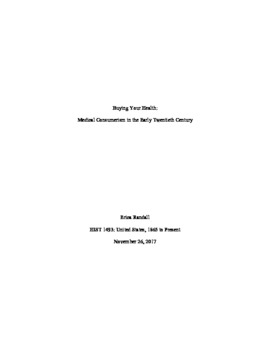Buying your health : medical consumerism in the early twentieth century Undergraduate
Abstract
After WWI, the United States saw an unprecedented rise in economic production and mass consumerism, an era that came to be characterized by wealth, prosperity, and vanity. Spurred on by the second industrial revolution, large corporations began mass- producing a variety of products, and for the first time in several decades, Americans had the monetary resources and economic freedom to purchase these products, including cars, household appliances, leisure items, etc. Advertisements played a significant role in this consumerism movement, and in the decades following WWI, advertising agencies refined their strategies to encourage individuals and families to purchase their products. Medicine and healthcare were not exempt from this overwhelming influence of consumerism, and during the 1920s and in following decades, Americans' accessibility to medicine and health products dramatically increased-as did their inclination to purchase self- prescribed medicine and products for a physical ailment rather than visit a doctor. This intertwining of medicine and consumerism was largely due to persuasive advertising strategies, including the use of universal language, the promise of self-improvement and disease prevention, and the idea that health products could negate the consequences of poor lifestyle choices.
